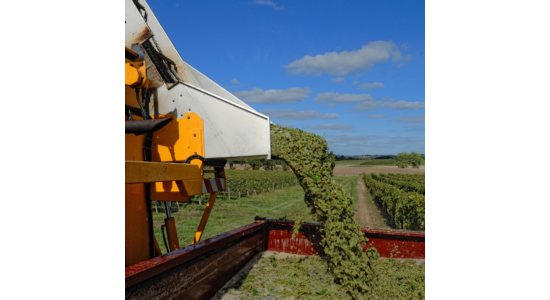While enjoying some freshly served tasty wines on a terrace on the slopes of Villány or Eger, probably you do not think of the journey the grapes have been making from the wine ranks to the glass. The bottle has probably been conveyed during filling, during packing, and during sales. But it is very likely that the very first occasion the product met with conveyor belts took place at the time of harvest. Special belts installed in a so-called grape-harvester or combine are collecting the freshly picked grapes for processing wine. Grape-harvester machines are manufactured by producers such as:
- Pellenc
- Gregoire
- ERO
- Braud New Holland
In this category, we can roughly distinguish two different types of machines.
At first, machines that need to be towed by a tractor or another agricultural vehicle. These combines cannot move independently, without help. While the machine is in action, the driver of the tractor has no time to simultaneously pay attention to the harvesting itself.
A second type is a self-propelled machine. Here, the driver can allocate his attention between the different tasks. In most modern versions, you need only one person to supervise the machine. Pretty much all the operational tasks the combine is able to fulfill independently. Of course, such machines have a corresponding price.
After the bunches have been removed from the stumps the conveyor belts in the combines collect and transport the grapes to the container. We can examine the pros and cons of any grape-harvester belt but their biggest enemies remain broken stems and bird feed materials that are getting stuck in the machine. In such cases, the belts can be totally damaged. In most cases, the belt just breaks and this can be easily repaired in our workshop by replacing an extension. In worse cases, some or even all of the cleats are literary broken-off from the belt, and then obviously the reparation takes a lot more work. Some machine-types are able to detect technical failures and give a system error signal that immediately stops the machine but unfortunately often the stop comes too late and the damage on the belt is already done.
In the worst case, not just the belt but also the transmission-motor is damaged. Because materials are getting clogged-up in the conveying system the belt stops moving, while the transmission engine keeps on pulling it. Consequently, the built-up friction heat can cause melt-down up to a half-meter section of the belt and can severely damage the coating of the transmission-motor.
If such components are not considered a total loss, it is always worth to have them repaired. Even if they are not immediately re-used and just kept as a spare, they can still be of great help to farmers during the harvesting season. The last thing you want is that the wine ranks are full of juicy grapes but the machine is out of order due to damaged belts and there are no spare belts available. At our belt production workshop, we have stocked up some of the most popular harvester belt-types (Pellenc, Gregoire) so we can always serve troubled farmers in need of immediate replacement. You can even pick them up personally to save the delivery time. In case you would need a less popular combine harvester belt, feel free to contact us anytime. Based on an accurate survey we are confident to find the best solution.
